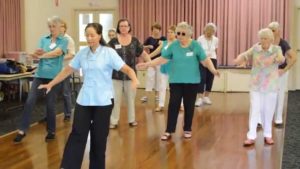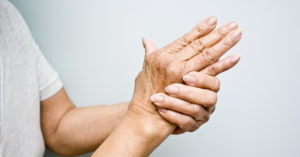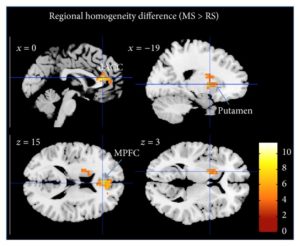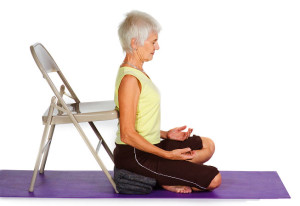
Improve Knee Osteoarthritis with Yoga
By John M. de Castro, Ph.D.
“Hatha yoga is an important non-medicinal method in rehabilitation of patients with knee osteoarthritis and will result in a significant decrease in pain and symptoms and a significant increase in daily activities, sports and spare-time activities, and quality of life.” – Gholam Ghasemi,
Osteoarthritis is a chronic degenerative joint disease that is the most common form of arthritis. It produces pain, swelling, and stiffness of the joints. It is the leading cause of disability in the U.S., with about 43% of arthritis sufferers limited in mobility and about a third having limitations that affect their ability to perform their work. In the U.S., osteoarthritis affects 14% of adults over 25 years of age and 34% of those over 65.
Knee osteoarthritis effects 5% of adults over 25 years of age and 12% of those over 65. It involves the whole joint, including articular cartilage, meniscus, ligament, and peri-articular muscle. It is painful and disabling. Its causes are varied including, hereditary, injury including sports injuries, repetitive stress injuries, infection, or from being overweight. There are no cures for knee osteoarthritis. Treatments are primarily symptomatic, including weight loss, exercise, braces, pain relievers and anti-inflammatory drugs, corticosteroids, arthroscopic knee surgery, or even knee replacement.
Mind-body practices in general have been shown to reduce the gene expressions that underlie the inflammatory response which contribute to arthritis. It is also known that gentle movements of the joints with exercise appears to be helpful in the treatment of knee osteoarthritis. This suggests that yoga practice, which involves both mindfulness and exercise of the joints may be useful for treatment. Indeed, yoga practice has been shown to be a safe and effective treatment for a wide variety of physical and psychological conditions, including arthritis. So, it would seem reasonable to look further into the effectiveness of yoga practice in treating knee osteoarthritis.
In today’s Research News article “The Effects of Yoga on Pain, Mobility, and Quality of Life in Patients with Knee Osteoarthritis: A Systematic Review.” See:
or see summary below or view the full text of the study at:
https://www.ncbi.nlm.nih.gov/pmc/articles/PMC5061981/
Kan and colleagues review the published research studies on the effectiveness of yoga practice for knee osteoarthritis. They found 9 published articles, with subjects between 51-70 years of age. Yoga practice was for 60-90 minutes per session and 3-4 sessions per week for from 8-20 weeks. Most of the studies included a control condition, most frequently comparing physical therapy plus yoga practice to physical therapy alone. They found that the literature uniformly reported that the yoga practice was safe, with no adverse effects and that it produced clinically significant decreases in knee osteoarthritis pain. Although the findings were mixed, overall there appeared to be improvement produced by yoga practice in movement and mobility, and the patients’ quality of life.
The published research strongly suggests that the practice of yoga is a safe and effective way to improve pain, mobility, and quality of life in people suffering with knee osteoarthritis. Yoga contains both exercise and mindfulness practice. The published studies did not separate these components. So, it cannot be determined if either alone or in combination are essential for effectiveness. But, it is clear that knee osteoarthritis patients can practice yoga and that it is a safe and effective practice to help relieve the symptoms of knee osteoarthritis.
So, improve knee osteoarthritis with yoga.
“Yoga is definitely one option for people with arthritis. Not only for the exercise benefits, but it’s also beneficial in the mind/body area, promoting relaxation and stress reduction,” – Sharon Kolasinksi
CMCS – Center for Mindfulness and Contemplative Studies
This and other Contemplative Studies posts are also available on Google+ https://plus.google.com/106784388191201299496/posts and on Twitter @MindfulResearch
Study Summary
Kan, L., Zhang, J., Yang, Y., & Wang, P. (2016). The Effects of Yoga on Pain, Mobility, and Quality of Life in Patients with Knee Osteoarthritis: A Systematic Review. Evidence-Based Complementary and Alternative Medicine : eCAM, 2016, 6016532. http://doi.org/10.1155/2016/6016532
Abstract
Objective. To systematically assess the effects of yoga on pain, mobility, and quality of life in patients with knee osteoarthritis. Methods. Pubmed, Medline, EMBASE, the Cochrane Central Register of Controlled Trials, Physiotherapy Evidence Database (PEDro), and other sources were searched systematically in this study. Two reviewers identified eligible studies and extracted data independently. Downs and Black’s Quality Index were used to evaluate the methodological quality of the included studies. Results. A total of 9 articles (6 studies) involving 372 patients with knee osteoarthritis met the inclusion criteria. The most common yoga protocol is 40~90 minutes/session, lasting for at least 8 weeks. The effect of yoga on pain relief and function improvement could be seen after two-week intervention. Conclusion. This systematic review showed that yoga might have positive effects in relieving pain and mobility on patients with KOA, but the effects on quality of life (QOL) are unclear. Besides, more outcome measure related to mental health of yoga effects on people with KOA should be conducted.
https://www.ncbi.nlm.nih.gov/pmc/articles/PMC5061981/








